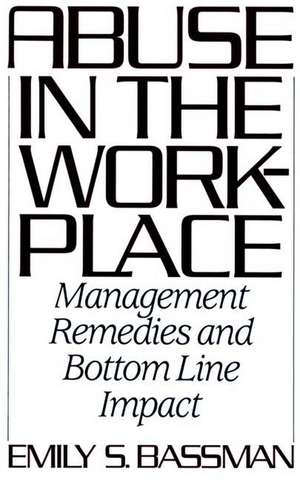Abuse in the Workplace: Management Remedies and Bottom Line Impact
Autor Emily S. Bassmanen Limba Engleză Hardback – 25 oct 1992 – vârsta până la 17 ani
Preț: 438.41 lei
Preț vechi: 604.56 lei
-27% Nou
Puncte Express: 658
Preț estimativ în valută:
83.89€ • 87.82$ • 69.41£
83.89€ • 87.82$ • 69.41£
Carte tipărită la comandă
Livrare economică 05-19 aprilie
Preluare comenzi: 021 569.72.76
Specificații
ISBN-13: 9780899306735
ISBN-10: 089930673X
Pagini: 224
Dimensiuni: 156 x 235 x 22 mm
Greutate: 0.55 kg
Editura: Bloomsbury Publishing
Colecția Praeger
Locul publicării:New York, United States
ISBN-10: 089930673X
Pagini: 224
Dimensiuni: 156 x 235 x 22 mm
Greutate: 0.55 kg
Editura: Bloomsbury Publishing
Colecția Praeger
Locul publicării:New York, United States
Notă biografică
EMILY S. BASSMAN is district manager with Pacific Bell in the area of Human Resource Planning. Before joining Pacific Bell, she spent ten years with AT&T, in various human resource and market research capacities. She is co-editor of Human Resource Forecasting and Strategy Development: Guidelines for Analyzing and Fulfilling Organizational Needs (Quorum, 1990).
Cuprins
IntroductionIndividual Acts of AbuseWhat Does Employee Abuse Look Like?"Traditional" Forms of AbuseThe Dynamics of Employee AbuseSocial and Behavioral Aspects of Abusive RelationshipsInstitutional AbuseThe Ethics of Employee TreatmentOverwork and the Workaholic OrganizationPolicies, Procedures, and Management PracticesPotential for New Forms of Abuse: Employee TestingPotential for New Forms of Abuse: Employee PrivacyImpact on OrganizationsThe Costs of Employee AbuseCorporate Response to Employee AbuseSolutionsGuidance for EmployersA Model for Examining the Corporate CultureThe Road AheadSelected Bibliography












